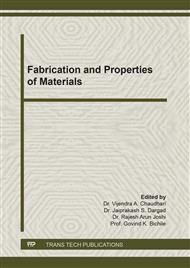[1]
Silveyra, J.M., et al., Soft magnetic materials for a sustainable and electrified world. Science, 2018. 362(6413).
Google Scholar
[2]
Harris, V.G., et al., Recent advances in processing and applications of microwave ferrites. Journal of Magnetism and Magnetic Materials, 2009. 321(14): pp.2035-2047.
Google Scholar
[3]
Dhand, V., et al., Synthesis and comparison of different spinel ferrites and their catalytic activity during chemical vapor deposition of polymorphic nanocarbons. International Journal of Precision Engineering and Manufacturing-Green Technology, 2017. 4(4): pp.441-451.
DOI: 10.1007/s40684-017-0049-3
Google Scholar
[4]
Thota, S., et al., Cation distribution in Ni-substituted Mn0. 5Zn0. 5Fe2O4 nanoparticles: a Raman, Mössbauer, X-ray diffraction and electron spectroscopy study. Materials Science and Engineering: B, 2016. 206: pp.69-78.
DOI: 10.1016/j.mseb.2016.01.002
Google Scholar
[5]
Anjum, S., T. Ilayas, and Z. Mustafa, Influence of antimony substitution on structural, magnetic and optical properties of cadmium spinel ferrite. Applied Physics A, 2020. 126(3): pp.1-11.
DOI: 10.1007/s00339-020-3407-x
Google Scholar
[6]
Özgür, Ü., Y. Alivov, and H. Morkoç, Microwave ferrites, part 1: fundamental properties. Journal of Materials Science: Materials in Electronics, 2009. 20(9): pp.789-834.
DOI: 10.1007/s10854-009-9923-2
Google Scholar
[7]
Yadav, R.S., et al., Impact of Nd3+ in CoFe2O4 spinel ferrite nanoparticles on cation distribution, structural and magnetic properties. Journal of Magnetism and Magnetic materials, 2016. 399: pp.109-117.
DOI: 10.1016/j.jmmm.2015.09.055
Google Scholar
[8]
Andhare, D.D., et al., Effect of Zn doping on structural, magnetic and optical properties of cobalt ferrite nanoparticles synthesized via. Co-precipitation method. Physica B: Condensed Matter, 2020. 583: p.412051.
DOI: 10.1016/j.physb.2020.412051
Google Scholar
[9]
Tatarchuk, T., et al. Spinel ferrite nanoparticles: synthesis, crystal structure, properties, and perspective applications. in International Conference on Nanotechnology and Nanomaterials. 2016. Springer.
Google Scholar
[10]
Bains, P.S., S.S. Sidhu, and H. Payal, Fabrication and machining of metal matrix composites: a review. Materials and Manufacturing Processes, 2016. 31(5): pp.553-573.
DOI: 10.1080/10426914.2015.1025976
Google Scholar
[11]
Ashiri, R., A. Moghtada, and A. Shahrouzianfar, Processing and characterization of carbonate-free BaTiO 3 nanoscale particles obtained by a rapid ultrasound-assisted wet chemical approach. Metallurgical and Materials Transactions B, 2015. 46(4): pp.1912-1923.
DOI: 10.1007/s11663-015-0377-z
Google Scholar
[12]
Sutka, A. and G. Mezinskis, Sol-gel auto-combustion synthesis of spinel-type ferrite nanomaterials. Frontiers of Materials Science, 2012. 6(2): pp.128-141.
DOI: 10.1007/s11706-012-0167-3
Google Scholar
[13]
Jun, Y.-w., J.-w. Seo, and J. Cheon, Nanoscaling laws of magnetic nanoparticles and their applicabilities in biomedical sciences. Accounts of chemical research, 2008. 41(2): pp.179-189.
DOI: 10.1021/ar700121f
Google Scholar
[14]
Chaturvedi, S., P.N. Dave, and N. Shah, Applications of nano-catalyst in new era. Journal of Saudi Chemical Society, 2012. 16(3): pp.307-325.
DOI: 10.1016/j.jscs.2011.01.015
Google Scholar
[15]
Solano, E., et al., Facile and efficient one-pot solvothermal and microwave-assisted synthesis of stable colloidal solutions of MFe 2 O 4 spinel magnetic nanoparticles. Journal of Nanoparticle Research, 2012. 14(8): pp.1-15.
DOI: 10.1007/s11051-012-1034-y
Google Scholar
[16]
Patade, S.R., et al., Synthesis and characterizations of magnetically inductive Mn–Zn spinel ferrite nanoparticles for hyperthermia applications. Journal of Materials Science: Materials in Electronics, 2021: pp.1-8.
DOI: 10.1007/s10854-021-05946-y
Google Scholar
[17]
Iqbal, M.J. and M.R. Siddiquah, Electrical and magnetic properties of chromium-substituted cobalt ferrite nanomaterials. Journal of Alloys and Compounds, 2008. 453(1-2): pp.513-518.
DOI: 10.1016/j.jallcom.2007.06.105
Google Scholar
[18]
Jadhav, S.A., et al., Magneto-structural and photocatalytic behavior of mixed Ni–Zn nano-spinel ferrites: visible light-enabled active photodegradation of rhodamine B. Journal of Materials Science: Materials in Electronics, 2020. 31: pp.11352-11365.
DOI: 10.1007/s10854-020-03684-1
Google Scholar
[19]
Esfe, M.H., et al., An experimental study on the effect of diameter on thermal conductivity and dynamic viscosity of Fe/water nanofluids. Journal of Thermal Analysis and Calorimetry, 2015. 119(3): pp.1817-1824.
DOI: 10.1007/s10973-014-4328-8
Google Scholar
[20]
Wen, D., et al., Review of nanofluids for heat transfer applications. Particuology, 2009. 7(2): pp.141-150.
Google Scholar
[21]
Choi, S.U. and J.A. Eastman, Enhancing thermal conductivity of fluids with nanoparticles. 1995, Argonne National Lab., IL (United States).
Google Scholar
[22]
Gupta, M., et al., A comprehensive review of experimental investigations of forced convective heat transfer characteristics for various nanofluids. International journal of mechanical and materials engineering, 2014. 9(1): pp.1-21.
DOI: 10.1186/s40712-014-0011-x
Google Scholar
[23]
Naik, S., et al., Influence of Co2+ distribution and spin–orbit coupling on the resultant magnetic properties of spinel cobalt ferrite nanocrystals. Journal of alloys and compounds, 2013. 566: pp.54-61.
DOI: 10.1016/j.jallcom.2013.02.163
Google Scholar
[24]
Sundar, L.S., et al., Enhanced thermal conductivity and viscosity of nanodiamond-nickel nanocomposite nanofluids. Scientific reports, 2014. 4(1): pp.1-14.
Google Scholar
[25]
Somvanshi, S.B., et al., Influential diamagnetic magnesium (Mg2+) ion substitution in nano-spinel zinc ferrite (ZnFe2O4): thermal, structural, spectral, optical and physisorption analysis. Ceramics International, 2020. 46(7): pp.8640-8650.
DOI: 10.1016/j.ceramint.2019.12.097
Google Scholar


